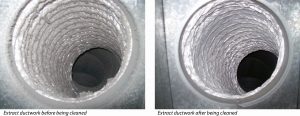
Air quality within social housing is an increasingly important issue; fire safety even more so. Adequately cleaning and maintaining the ventilation system in multiple occupancy buildings is essential for legal compliance and for ensuring the health and safety of the property. Gary Nicholls, Managing Director of Swiftclean Building Services, explains.
There is the potential for fire to spread from home to home in multiple occupancy housing. However, it was not until the last decade that fire legislation for this type of housing was introduced with the passing of The Regulatory Reform (Fire Safety) Order 2005, which came into force in October 2006.
Within multiple occupancy buildings, much care has been given to ensuring that each dwelling is effectively a separate compartment so that the risk of fire spreading is greatly reduced. Sharing ventilation and extract ductwork for kitchens and bathrooms, however, re-introduces a potential route for fire. Communal ductwork represents a potential weakness in terms of the spread of fire and also a possible cause of widespread poor air quality.

Fire dampers
To restore some of this compartmentation when needed, fire dampers can be installed in the ductwork at the point where it passes through a fire resistance-rated wall. These are essentially a set of steel louvres that remain open to allow free airflow under normal conditions, but which are triggered by sensors to close automatically in the event of a fire. The closed louvres form a barrier to prevent the spread of flames and hot gases, helping to delay the spread of fire from its point of origin to other parts of the property.
Where fire dampers are fitted, they must be tested and cleaned on an annual basis in accordance with British Standard BS:9999 2017 using a method called drop testing, which confirms that the louvres close effectively. It used to be the case that the frequency of testing depended on the construction of the fire damper, but the 2017 revision to BS:9999 made annual drop testing, cleaning and any necessary repairs for every type of fire damper mandatory.
Kitchen extract fire safety cleaning should also be a priority. It is an inevitable result of everyday cooking that deposits of fat, oil and grease build up as a thin film throughout the kitchen extract ductwork. These deposits represent a real fire risk and must be removed on a regular basis. The frequency of cleaning is laid out in tables within TR/19, which is the leading guidance document for ventilation ductwork cleaning, issued by BESA (Building & Engineering Services Association). This also requires ductwork to be classified as high, medium or low. Multiple occupancy shared kitchen extracts will carry a high classification, requiring regular thorough cleaning.
Planned preventative maintenance
In refurbishments, especially kitchen and bathroom replacement programmes, consideration should be given to updating the ventilation systems as well as the units and sanitaryware. A clogged or greasy extract fan will also consume more electricity than a clean one, so this should be included in energy saving plans.
Where a common warm air system serves the entire building, it should be replaced, where possible, by individual self-contained heating systems so that common areas and dwellings do not share the same system. Alternatively, Swiftclean Building Services can replace the original grills with fire rated valves which help to contain the spread of fire.
Bathroom ventilation systems often draw in dust, fibres and dirt particles which begin to clog the system. This can make it less effective, allowing less air to circulate and causing unpleasant odours. Regular cleaning to TR/19 guidance is important to ensure a good indoor air quality.
Planned preventative maintenance is vital in multiple occupancy buildings. Gaining access to dwellings in order to carry out this cleaning may be difficult, but should be a priority; it will be essential to communicate the importance of this regular maintenance to occupants so that access for cleaning is granted. In every communal ventilation system, regular cleaning and testing is not only a legal requirement, but a vital safeguard for residents and visitors.








